Samsung QN900A review (75QN900A): The T3 Awards 2021 winner for Best TV
The Samsung QN900A is a marvel, delivering world-beating HDR and detail like you've never seen before

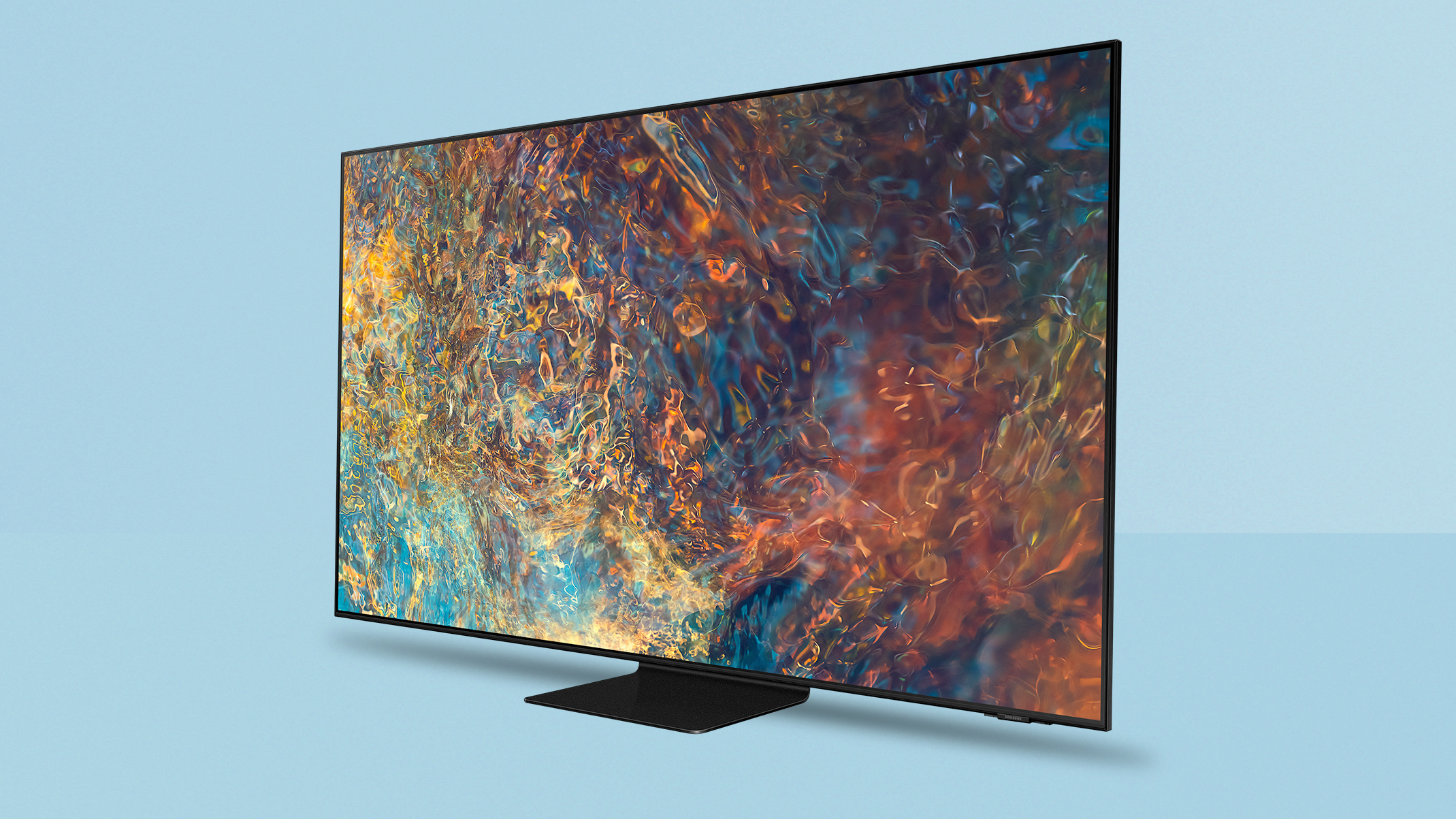
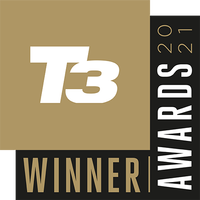
The Samsung QN900A leads the Mini-LED revolution. It’s hard to imagine how any other TV in 2021 might take more spectacular advantage of this technology than Samsung’s dazzling 8K flagship.
-
+
Phenomenally bright, colourful HDR pictures
-
+
Stunning backlight control and OLED-grade black levels
-
+
Four HDMI 2.1 ports
-
-
No Dolby Vision or full Atmos support
-
-
Some over-punchy picture presets
-
-
Still no native 8K content
Why you can trust T3

In our Samsung QN900A review, we're turning our attention to Samsung's flagship TV for 2021 – the most technologically advanced LCD TV it's ever made. Having already impressed with its debut 'Neo QLED' Mini-LED TV in our Samsung QN95A review, the focus is now on 8K, and the result is absolutely incredible, rocketing straight to the top of our list of the best TVs, as well as best 8K TVs.
The QN900A range is represented here by the 75-inch model, which features all the advantage that Samsung is loading up on its 8K range vs the elite 4K option. The QN900A greatly increases the Mini-LED backlight ‘zone’ count, offers four times as much resolution as a 4K TV, sports an improved Object Tracking Sound audio system, and drastically increases the AI processing power applied to optimising incoming pictures to the screen’s ground-breaking capabilities.
When you add it all up, it makes for the best TV that we've seen so far – in fact, it was crowned both Best TV and Best 8K TV at the T3 Awards 2021.
It's especially if you're buying at larger sizes, where the extra pixels of 8K are most noticeable, making it absolutely top of the best 65-inch TVs, best 75-inch TVs and our list of the best 80+ inch TVs. The HDR performance is second to none, and it can make 4K video look better than 4K convincingly… it really is the elite TV of 2021.
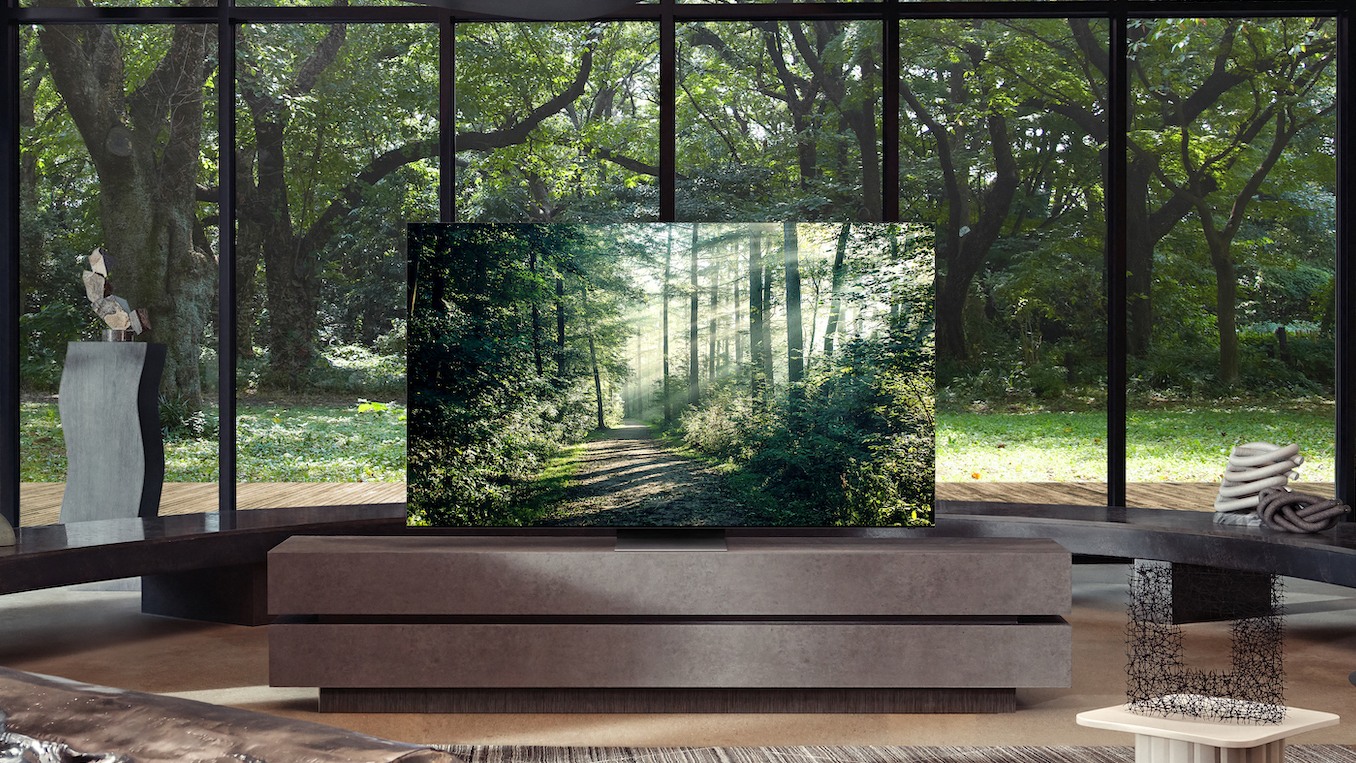
Samsung QN900A review: Price & release date
The QN900A’s ‘premium’ status is very much reflected in its hefty price (and hefty sizes). It comes in three models, and the lowest-priced is the 65-inch version, which costs £5,999/$4,999/AU$6,799. Step up to the 75-inch version we reviewed and you're looking at £7,999/$6,999/$AU9,499. For the 85-inch version, this rises to £11,999/$8,999/AU$12,499. It's worth checking our Samsung discount codes to see if you can save on your order.
It was launched in spring 2021, and these are the official launch prices, so we'd expect them to come down over time – Samsung TVs tend to get a lot of discounts and cashback offers. That applies to both its more budget TVs as well as these high-end models – it's just that the high-end models still cost a lot even with price cuts. You can see the latest lowest prices just below.
The QN900A is, of course, an 8K TV rather than a 4K one, so that massive increase in pixel numbers partly explains the high price of entry. That said, Samsung got some of its 8K pricing down into high-end 4K TV territory last year, so we need to dig deeper to find what really makes Samsung think the QN900A is worth so much.
Get all the latest news, reviews, deals and buying guides on gorgeous tech, home and active products from the T3 experts
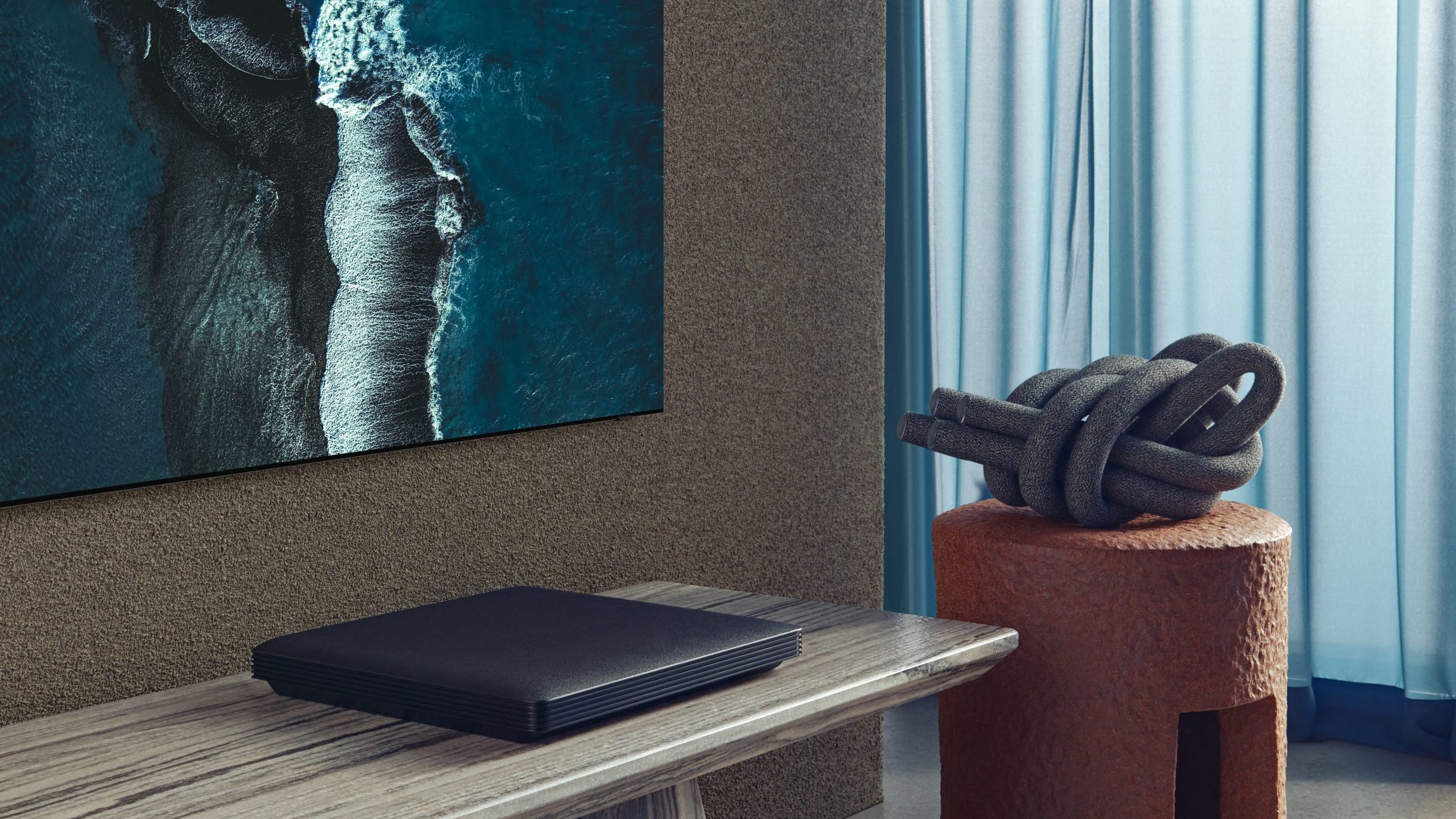
Samsung QN900A review: Features & what's new
The remarkable frameless design makes a premium statement – as we’ll discuss in more detail later – and help this to feel like it's an object worthy of your large investment. It's very similar to last year's Samsung Q950TS for looks overall on the outside, but it's all change inside.
The real heart of the QN900A’s charms turns out to be its backlight system, and how that’s marshalled by and combined with Samsung’s startlingly powerful new image processing.
That backlighting uses Mini-LED technology. This sees Samsung removing the customary bulky packaging and lenses traditionally provided with LCD TV LEDs, so that far more of them can be fitted behind the screen. This in turn enables Samsung to deliver, with the aid of its new processing system, far more localised light control than you can achieve with regular LCD technology.
The 65-inch QN95A 4K equivalent to this TV provides 792 separate dimming zones, compared with just 120 on 2020’s equivalent, non Mini LED 4K model (the Samsung Q95T). The 75-inch QN900A, however, ups the local dimming zone count to a mammoth 1,920 – nearly three times the level of refinement the 4K model offers.
Being able to individually control the light output at any given moment of so many separate areas of the image should have a profound impact on picture quality, when it comes to everything from brightness, contrast, and backlight uniformity to colour. Provided the processing controlling all those light zones in real time is up to the job, of course.
Fans of OLED TV will likely at this point be screaming that 1,920 dimming zones is still puny compared with the way OLED technology allows every individual pixel to make its own light. That’s true. But the QN900A can do something OLED cannot: hit seriously high peak brightness levels (measured on a 10% of screen area white HDR window) of 1,683 nits in Standard mode. In fact, it peaked at a mammoth 4,000 nits using the Dynamic preset, but only very briefly before dimming down dramatically.
The QN900A’s screen tech is QLED, as with all of Samsung’s premium TVs for the past few years. This is designed to deliver rich colours while allowing for that big brightness.
The all-important Neo Quantum processor responsible for getting the best out of the Samsung QN900A’s screen is a big step up from Samsung’s previous systems, not least because this version bases all of its real-time image optimisation decisions on a database of picture knowledge accumulated from 16 separate neural networks. Last year’s Samsung 8K models carried AI developed from just a single neural network, so this model has a much greater understanding of what images are supposed to look like.
While its efforts will impact many aspects of the QN900A’s pictures, the main target of the latest AI technology is improved upscaling of sub-8K sources. Which is pretty important, after all, given that native 8K content remains effectively non-existent.
Unlike some other supposedly 8K TVs, the QN900A is at least ready for more native 8K sources as and when they arrive. All four HDMIs on its external One Connect connections box are HDMI 2.1 ports, capable of handling up to 40Gbps of data – enough to carry 8K video. Samsung’s set also supports 8K streaming codecs, and can play 8K files via USB.
The HDMIs also support 4K 120Hz frame rates, along with AMD FreeSync, HDMI VRR and Nvidia G-Sync variable refresh rate technology. This, of course, potentially makes it a dazzling big-screen display for use with the Xbox Series X, PS5 and the latest premium PC graphics cards. Especially as the cutting edge game-friendly connectivity is backed up by input lag as low as 9.6ms and Samsung’s new Game Bar, which gives you a helpful at-a-glance view of all the settings you’re using while playing a gaming source.
The QN900A carries the latest evolution of Samsung’s Object Tracking Sound system. This uses speakers positioned all around the screen frame, rather than just pointing down from the bottom edge as so often happens with ultra-thin TV designs, to hopefully create sound that really seems to be coming from the screen, right down to sound effects seeming to follow noisy objects around the screen.
You can also use Samsung’s Q Symphony technology to combine the QN900A’s speakers with some premium models from Samsung’s soundbar range, including the Samsung HW-Q800A. This will give you a larger soundstage with more direct height effects.
There’s no Dolby Atmos decoding built into the TV, but it can pass Dolby Atmos through to a soundbar or AV receiver thanks to HDMI port 3’s support for eARC audio transfer technology.
While we’re on the subject of Dolby, the QN900A also does not support the Dolby Vision advanced HDR format. It does at least support the rival HDR10+ format, which joins Dolby Vision in providing extra scene by scene information to the HDR video stream to help TVs produce more dynamic, accurate images. There are a growing number of rival TVs, though, that now sensibly support both premium HDR formats, and content typically only supports one format or the other (with Dolby Vision being by far the most common), rather than both.
Smart features, finally, are provided by Samsung’s Tizen-based Eden system. This is impressively comprehensive in terms of the apps it supports, and is tidily built around compact menus that sit over only the bottom part of the image, meaning you can still watch TV while you browse.
For UK buyers, the only frustration is that while all the key UK terrestrial broadcaster catch up apps are present, they aren’t available within the helpful Freeview Play wrapper.

Samsung QN900A review: Picture quality
We already thought the picture quality of the QN95A was excellent, but the QN900A is on another level.
The huge jump up in dimming zones is the star of the show, delivering both much better contrast and less backlight blooming in a genuinely fearsome demonstration of why Mini-LED technology looks set to be such a game changer for LCD TVs.
On the contrast front, black levels can get so deep that the screen completely disappears during a fade to black in a darkened room, a trick previously the exclusive domain of the best OLED TVs. At the same time, though, the QN900A delivers bright highlights with a real step up in intensity and brightness versus the QN95A – a TV which itself already delivered a significant local contrast boost compared with any of Samsung’s previous, non Mini-LED, LCD TVs.
This extra local intensity is possible, of course, because the much more localised light control the 8K model offers means there’s no need to compromise the brightness of the lightest areas of the pictures sin order to preserve the uniformity and depth of black levels in any surrounding dark areas.
Also impressive is how quickly and smoothly the QN900A transitions from dark to light shots, and back again. There’s no significant lag in even the most abrupt shifts, no sign of unwanted noise in near-dark areas, and no sudden flickers or instabilities as the TV adjusts its backlight to cope with subtle shifts in light levels in dark shots.
Essentially the QN900A produces by far the most impressive combination of extreme contrast and minimal backlight flaws I’ve ever seen on an LCD TV. It’s in this respect, too, that it most justifies its substantial extra cost over Samsung’s QN95A 4K models.
While the QN900A breaks the most new ground with its Mini-LED contrast thrills, it also improves on 2020’s 8K models with its new AI upscaling. With a pristine 4K source, such as a good 4K Blu-ray, the upscale is pretty much flawless, clearly introducing extra pixel density and sharpness compared with all the 4K TVs I ran side by side tests with.
There don’t appear to be any really significant negative processing side effects caused by the 8K upscale either, be it blurring, smearing, lag or over-stressed object edging. Overall there’s a significant step up from even the already impressive upscaling of 2020’s Samsung 8K TVs.
I should say that the strongest upscaling results appear when using the Standard or (over the top) Dynamic settings. The Movie and Filmmaker modes look significantly softer with 4K sources. But at the same time, the level of sharpness in these modes is more authentic to the source material, which is what people using those modes want to see.
The prowess of the new Neo QLED processing is even more striking with HD sources. HD pictures don’t look fully 4K (never mind 8K) but they do look clean, natural, and remarkably free of noise. Grain is typically handled fantastically well, too, looking neither exaggerated nor too smoothed out.
Even standard def sources, meanwhile, are actually for the most part enjoyable to watch – and that’s the first time I’ve felt really comfortable to say that about a 75-inch 8K screen.
Colours retain their tonal balance and authenticity through the upscaling process, too, which again is true even when watching an SD source.
If you can find any 8K content (we used a native 8K demo reel from Spears & Munsil), it will look so ridiculously good on the 75QN900A, bolstered by the screen’s ground-breaking contrast, that you’ll end up passionately hoping that 8K does become readily available one day.
While the QN900A is built to shine – literally – with high dynamic range sources, it also steps down to SDR very nicely. It tracks pretty effectively to standards in Movie mode, but more exciting for many owners, I suspect, is how well the latest Standard preset presents SDR with more aggression and brightness without the image losing balance or looking forced.
The only negative about the Standard setting with SDR is that the very brightest parts of the picture – bright images outside windows, or sunlight reflecting off skin – can sometimes lose a little subtle shading information.
One other increasingly important aspect of the QN900A’s picture performance for today’s world is gaming. And here, again, the set is on mostly spectacular ground. It has no trouble playing full 4K at 120Hz on any of its HDMI ports, for starters. And seeing such a combination of native resolution and fluidity from the likes of Call Of Duty Black Ops: Cold War on Xbox Series X or PS5 on such a huge, pixel-stuffed screen really is an experience you’ll never cease to be awestruck by.
The QN900A’s extreme brightness and colour range also plays seriously nicely with the HDR graphics now being deployed by the majority of next-gen games. And since LCD TVs don’t use organic components, you don’t have to worry about all that brightness and intensity potentially leading to permanent image retention.
The extra dimming zones the QN900A carries also helps it avoid most of the slight backlight blooming issues in Game mode found with the QN95A, while the variable refresh rate support works well with all of the AMD Freesync, HDMI 2.1 VRR and Nvidia G-Sync formats.
The only issues with gaming on the QN900A are a slight flickering in some game menus (though seldom if ever during actual game play) when using VRR, and somewhat soft and muted pictures using the default settings activated if you’re using the AMD Freesync Pro VRR system.
Having raised a couple of small negatives, now seems the appropriate time to raise a few more. Even this kind of money doesn’t get you absolute perfection.
On the colour front, reds can look a touch pink sometimes. Also, despite the unprecedented (for an LCD TV) localised light control, very small bright objects, such as isolated stars or eyes gleaming in the dark, can still dim down quite heavily as the TV seeks to remain clear of backlight blooming.
Very dark scenes can sometimes feel a little short of shadow detail when using the otherwise excellent Standard mode, and there can occasionally be a slight shimmer to areas of extreme detail.
While backlight blooming is very hard to spot when viewing the QN900A fairly straight on, it becomes more noticeable from medium-wide viewing angles. Finally, while many things about the QN900A’s Standard preset feel well thought through for getting the maximum impact from the screen’s startlingly capabilities, the default motion processing settings aren’t helpful at all.
There’s obvious distortion around the edges of moving objects, and some occasional flickering with small areas of particularly fast motion, too. You’ll need to turn motion processing off entirely, or set the motion settings to Custom with the blur and judder reduction elements set to just three or four, before 24 frame a second sources lose the unwanted side effects.
The QN900A’s issues, though, are either surmountable by tweaking the settings, or else hugely outgunned by the ground-breaking picture quality advances the TV makes.

Samsung QN900A review: Sound quality
If you’re hoping for sound quality that’s as good relative to the competition as its class-leading pictures, prepare to be disappointed. If, on the other hand, you take the view that it’s surprising that any TV with essentially no bezel and a slim rear can produce decent sound, then the QN900A holds up very well.
The main strength of the QN900A’s sound is its combination of a large sound stage with its ability to position sound effects in the place on the screen where they’re supposed to be coming from. This makes the soundstage feel alive, dynamic and detailed. And since the speakers mounted into all of the TV’s edges achieve this without succumbing to distortions or harshness, it’s easy to get drawn into the action.
With no less than eight visible drivers firing out from the QN900A’s svelte rear, it’s no surprise to find action scenes underpinned by decent amounts of bass.
There is a limit to what the QN900A can do sonically, though. The sound doesn’t project forwards all that much, for instance. Its presence is therefore mostly restricted to width and height around the screen, rather than all around you.
Second, even eight mid-range/bass drivers doesn’t prove enough to deliver really deep and well projected bass. This, together with a fairly low maximum volume (even when using the provided Amplify mode), adds to the feeling that while the sound is clean, clear and balanced, it’s also a little muted and ‘hemmed in’.
Don’t forget, though, that if you buy one of Samsung’s new soundbars from the Q70A model upwards, you can combine it with the TV’s speakers using Samsung’s Q Symphony technology to create a much larger, more impactful sound – though any of the best soundbars will work with it, so an upgrade is easy whatever kind of thing you're looking for.
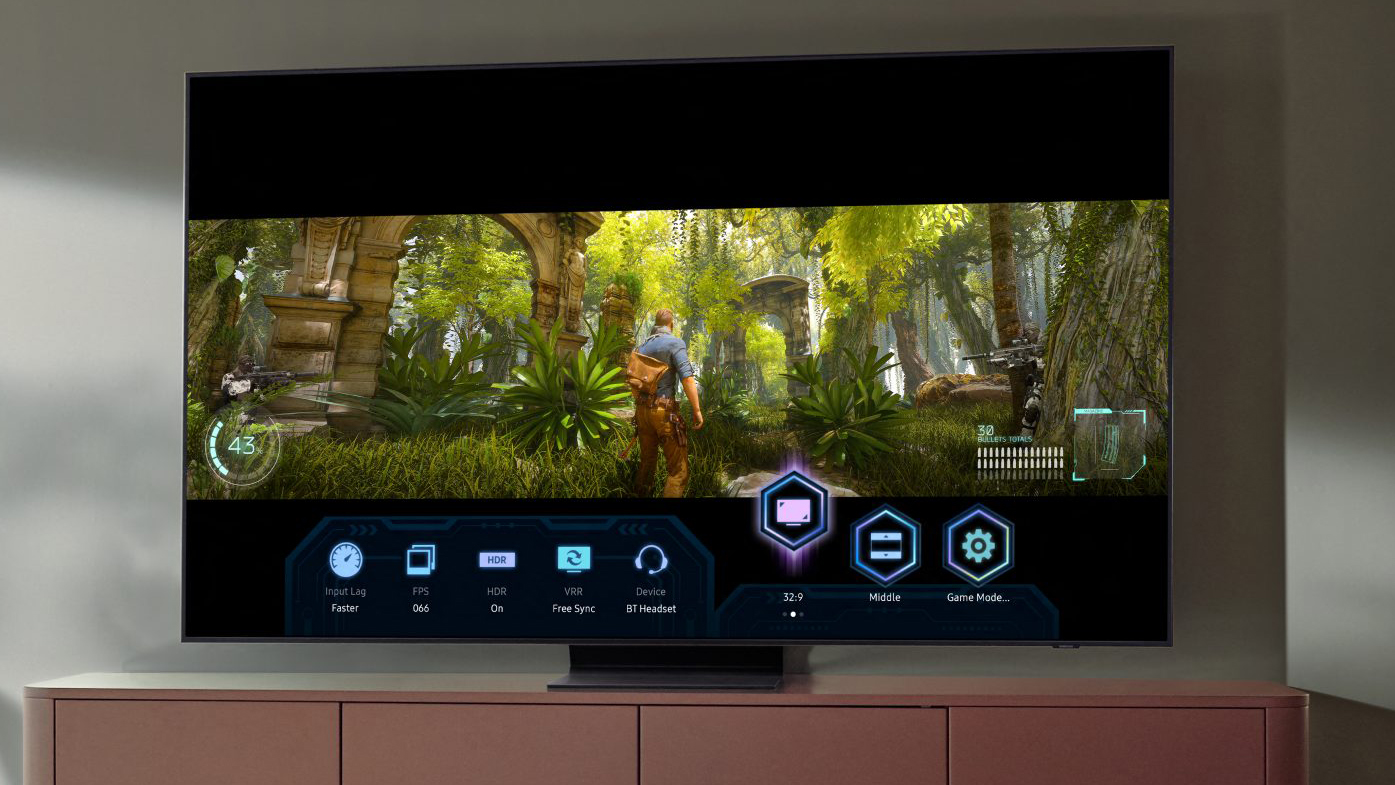
Samsung QN900A review: Design & usability
The 75QN900A looks every bit as cutting edge and premium as you’d hope a TV at this price would look.
The star of the show is its bezel. Or rather, its lack of bezel. Unless you look really, really hard, from the front you’ll struggle to see any frame around the screen at all. It’s just a picture hanging in mid air.
From an angle the bezel does become visible. However, the side panels are much slimmer than those of the QN900A’s predecessor, and they’re also seriously attractive with their gleaming perforated metal finish. The perforations being there to enable speakers built into each edge to get their sound out.
Aside from a fiddly-to-attach stand, Samsung’s flagship 75-inch TV for 2021 is fairly straightforward to both initially set up and use. It auto detects all sources you attach to it, automatically switches in and out of Game mode, and its Eden smart system is easy to use and find content on.

Samsung QN900A review: Verdict
Samsung’s QN95A has already given us a fantastic first glimpse at what Mini-LED technology can do in the company's hands. By nearly tripling the number of dimming zones, though, the 75QN900A raises the bar even higher, combining extreme brightness, colour and 8K sharpness with unprecedented levels of contrast and backlight control to produce the all-round most spectacular pictures I’ve seen on a TV that's remotely affordable.
The 75QN900A isn’t necessarily an ‘OLED killer'; there will still be plenty of people attracted to OLED’s unique, pixel level lighting advantages. However, 8K OLED TVs are still currently eye-wateringly expensive – even more so than this.
Also, for anyone drawn to the spectacular side of HDR, especially if they have a bright room to satisfy, the QN900A combines the brightness extremes of LCD with more of the contrast control traditionally associated with OLED far more emphatically than any LCD TV we’ve ever seen before.
Samsung QN900A review: Also consider
I've mentioned the Samsung QN95A a lot here – if you want the 4K (and less expensive) version of this, then it's an excellent choice overall. We've talked about the areas where the QN900A bests it, but it still blew us away in our full Samsung QN95A review.
LG's G1 is currently the elite OLED TV of choice, if you're looking for the OLED alternative to this. In terms of features it's generally an easy match for the QN900A, with its array of HDMI 2.1 ports, great smart features, and incredible processing. However, it's a 4K screen, and being OLED it's not as bright as the QLED LCD panel here – though it can offer those absolutely perfect pixel-level highlights. Here's our full LG G1 review.
LG is making its own Mini-LED 8K TVs, which may be where the cat really gets itself among the pigeons. We haven't had a chance to review the LG QNED MiniLED 99 screens yet, but one leaked price suggests that LG might undercut Samsung's prices by around 20%, so we'll see what happens when they arrive in a couple of months.
John Archer has been testing TVs and AV gear for over 25 years, having worked on Home Cinema Choice magazine. He's a contributor to Forbes, TechRadar, Trusted Reviews, Wired and many more places – if you've owned a TV in the last couple of decades, John's probably reviewed it somewhere. He's seen so many hot new technologies come and go, like tears in the rain.
